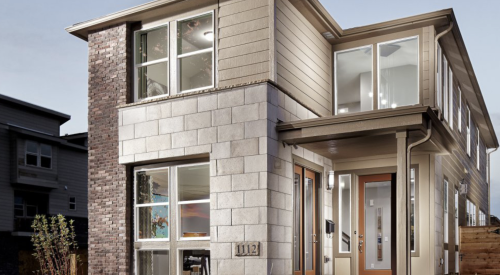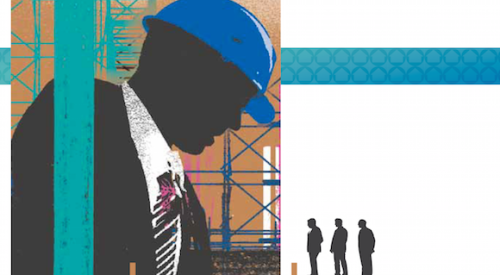|
With quick wits and fast feet, Kimball Hill Homes Chairman David K. Hill survived the crash of housing markets in California, Nevada, Florida and Illinois during 2006. Now he's gathering his energy to deliver a knockout blow in 2007.
Hill saw trouble coming a year ago. "Our wake-up call came in January 2006," he says now. "We were lulled to sleep during our first quarter of fiscal 2006 (October through December 2005) because we had the best margin closings in the history of the company. When we looked at declining sales, it was easy to attribute them to seasonal factors.
 David K. Hill, Chairman, Kimball Hill Homes. |
"We cut starts in March and April, then cut some more in May and June. And we started matching net sales to inventories rigorously. By the time we got to year-end (Sept. 30, 2006), while our unit volume and revenues were up over the previous year, our margins were sharply down." (Kimball Hill is likely to climb in this year's Giant 400 rankings, as revenues increased to $1.164 billion in fiscal 2006, up from $1.11 billion in 2005. Closings increased to 4,079 from 3,881.)
Hill believes his fiscal year, which ends earlier than those of most builders, allowed his team to see threats sooner. "As we gulped, we saw the challenges emerging, but we also started to see ways of dealing with them."
Shape of Things to ComeHill says controlling inventory is the first step toward recovery. "Our inventories were down sharply by September," he says. He's also fortunate to build in Texas, where housing markets are still relatively healthy. Kimball Hill has big operations in Dallas and Houston, smaller ones in Austin and San Antonio. But Hill is already adjusting both product and pricing to what he sees as new reality: "We've been moving down in product size in California and Las Vegas for two years. Lower price points are going to be a long-term trend in California."
Hill believes the new communities KH opened in 2006 are now a big advantage. "We're able to adjust prices from the get-go," he says. "That allows us to get stronger sales — and firmer — without the high cancellation rates you see when you have to adjust prices in the middle of a project. In an established community, with profitable sales in backlog, it's big trouble when you hit a cliff and the market tanks. You have 50 houses on the top of the cliff, but the only place you can get sales is at the bottom. If you drop your prices, even by using incentives, you're going to hear from the people on the top of the cliff. Or they may just walk before closing."
Who Wants Land?Hill has moved from land buyer to seller but foresees moving back into land acquisition by mid-2007: "We'll sell more ground, but only where we can do it and not get clobbered. We haven't committed to a significant land buy in more than a year. When we go back into buying depends on the local markets.
"Builders buy land based on their expectation of market conditions in two to three years," he says. "The right time to buy is when the housing market has bottomed but before there are clear signs of recovery. That's when land sellers will finally give up the high hopes they had when the market was hot."
He believes buying land ahead of the coming recovery may fall into what he calls his 18-month rule: "If a market really began to weaken in November and December of '05, I'd look for significant land transactions to begin in June or July of '07," he says.
But even before that, he predicts keen-eyed builders will find "spots of warmth" in close-in locations. "Urban housing is hot. It will only get hotter when these markets come back," he says. "Lettuce turns brown around the edges, and so do housing markets. The center stays green. Builders with good product will find ways to make money on urban in-fill sites."
Shakeout at the Top?Hill does not believe public builders have an advantage during the market contraction. "A number of bigs believe their size allows them to minimize the hit they take by increasing their activity," he says. "While everybody is groaning, they still try to grow. The most frequently-cited proponent of this groan-but-grow strategy is Lennar. But smaller builders have lower overhead. They can take a reduction in activity; they just can't take selling houses for a loss. Their option is to shrink and wait. The big guys are flexing their muscles right now," Hill observes, "but they are also absorbing significant negative economic results. What happens next probably depends on how long this sales trough lasts."
However, Hill does believe more consolidation is in store. "I think we'll see significant private equity players looking at (acquisition) deals soon. The public builders have less appetite right now. Their stocks are still down 35 percent to 55 percent from where they were a year ago. Still, there are multi-billion-dollar private equity transactions flying around, although not yet in housing. There's a lot of private capital out there."
Hill's Cash PlaysAs for Kimball Hill, look for the firm to follow a conservative growth tack now that its balance sheet is looking better, thanks to equity and debt moves in the last year that added cash to the coffers.
In addition to selling land, the company issued $203 million in publicly traded bonds in 2006. "With the bond offering, we're now semi-public," Hill says. But he doesn't anticipate doing more of it. "We did it for growth support and to strengthen our financial statement."
Add one more cash source: recent SEC filings revealed that a major, third-party institutional investor bought 952,000 shares of Kimball Hill common stock for $110 million. Hill says he wouldn't have done it, except that many of his employees are in position to retire. "This gives us the opportunity to sell stock that, if the employees retired, we'd have had to purchase. It did away with the overhang of those redeemable shares."
Dave Hill also made a major commitment toward management succession at Kimball Hill as C. Kenneth Love moved up to vice chairman and president of the company and heir apparent. Says Hill: "I don't plan to do this until I'm 80!" We don't look for that transition to happen until Kimball Hill is growing the bottom line again, as well as the top.
| |||||||||||||||||||||||||||












